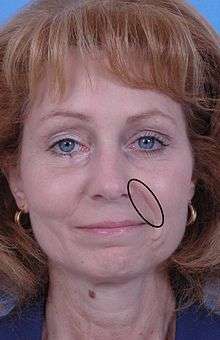Nasolabial fold

Human face, with left nasolabial fold marked in black ellipse
The nasolabial folds, commonly known as "smile lines"[1] or "laugh lines",[2] are facial features. They are the two skin folds that run from each side of the nose to the corners of the mouth. It is defined by facial structures that support the Buccal fat pad.[3] They separate the cheeks from the upper lip. The term derives from Latin nasus for "nose" and labium for "lip".
Cosmetology issues
With ageing the fold may grow in length and depth.[4] Dermal fillings may be used to replace lost fats and collagen in this facial area.[5]
See also
References
- ↑ Burgess, edited by Cheryl M. (2005). Cosmetic Dermatology. Berlin, Heidelberg: Springer-Verlag Berlin Heidelberg. p. 106. ISBN 9783540273332. Retrieved 20 February 2015.
- ↑ Vennemeyer M. D., Michael D (22 December 2010). Plastic Surgery Myths Dispelled. Xlibris Corporation. p. 35. ISBN 9781456835958. Retrieved 20 February 2015.
- ↑ Pogrel, MA; Shariati, S; Schmidt, B; Faal, ZH; Regizi, J. "The surgical anatomy of the nasolabial fold.". PubMED. Retrieved 20 February 2015.
- ↑ Wulc, Allan E.; Sharma, Pooja; Czyz, Craig N. (2010). "The Anatomic Basis of Midfacial Aging". Midfacial Rejuvenation. doi:10.1007/978-1-4614-1007-2_2.
- ↑ "Why your face ages and what you can do". www.health.harvard.edu/. Harvard Health Publications. 14 September 2010. Retrieved 23 February 2015.
This article is issued from Wikipedia - version of the 11/7/2016. The text is available under the Creative Commons Attribution/Share Alike but additional terms may apply for the media files.